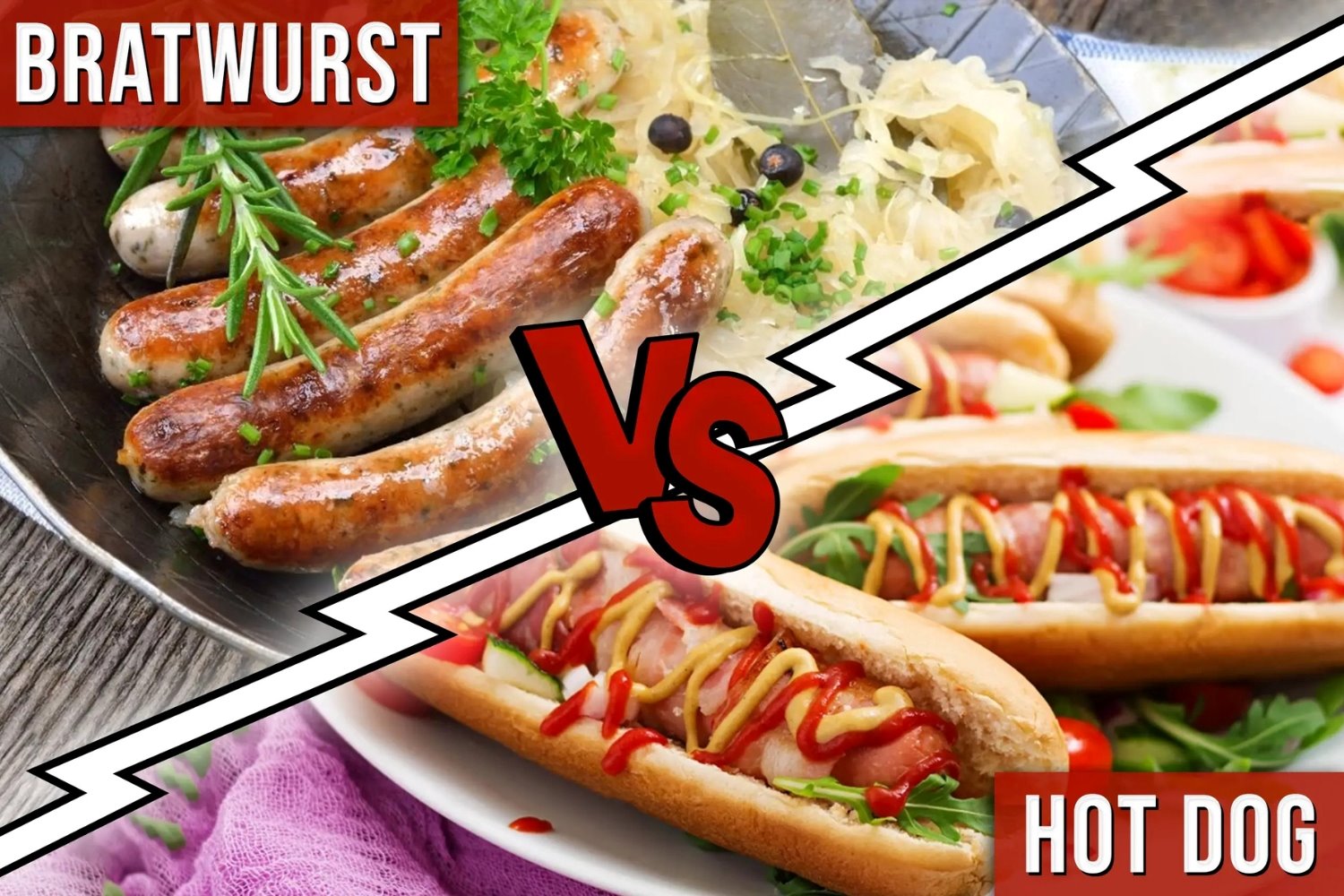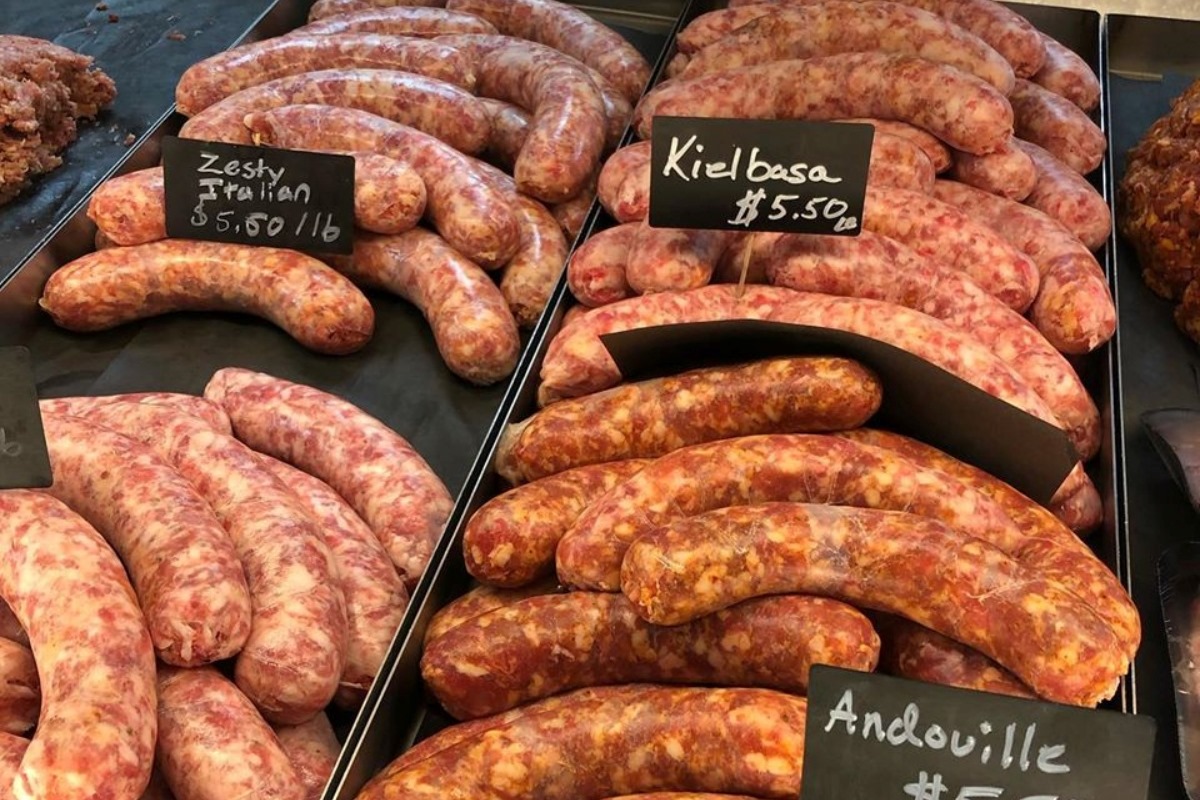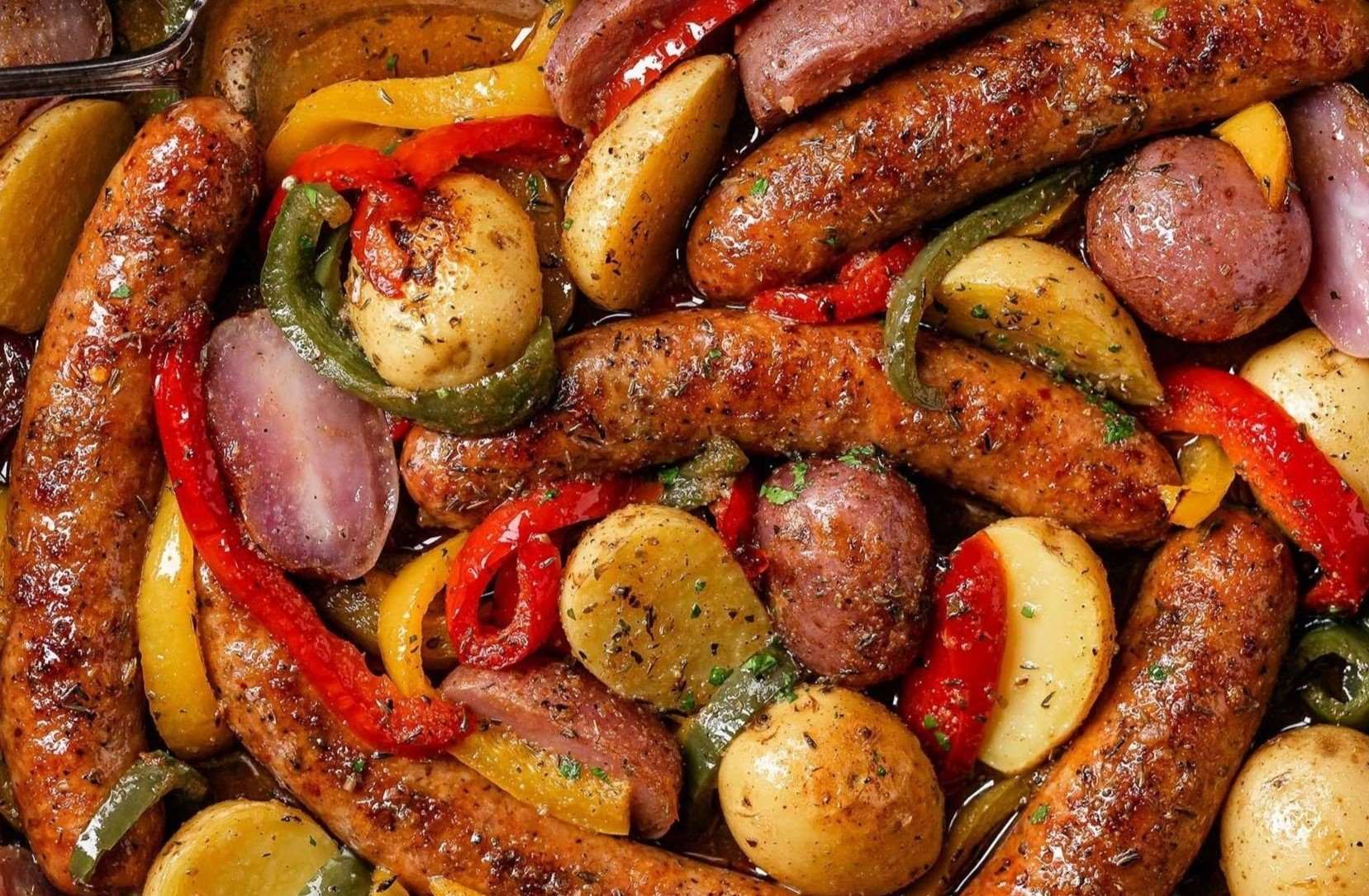Home>Food and Cooking>Hotdog Vs Bratwurst: Unveiling The Sizzling Secrets Of America’s Favorite Sausages


Food and Cooking
Hotdog Vs Bratwurst: Unveiling The Sizzling Secrets Of America’s Favorite Sausages
Published: January 30, 2024
Discover the mouthwatering battle between hotdogs and bratwurst, and uncover the secrets behind these beloved American sausages. Explore the world of food and cooking with our sizzling insights.
(Many of the links in this article redirect to a specific reviewed product. Your purchase of these products through affiliate links helps to generate commission for Noodls.com, at no extra cost. Learn more)
Table of Contents
Introduction
When it comes to sizzling sausages, few can rival the iconic status of hotdogs and bratwurst in American cuisine. These beloved staples have secured a special place in the hearts and taste buds of food enthusiasts across the nation. As we embark on a flavorful journey to unravel the distinctive characteristics of these two delectable sausages, we will delve into their rich history, explore the unique ingredients and preparation methods that set them apart, uncover the diverse cooking techniques employed, and ultimately uncover the regional variations that add an extra layer of depth to their culinary allure.
Prepare to be tantalized by the aroma of sizzling sausages as we venture into the heart of hotdog and bratwurst culture. Whether you're a culinary connoisseur or a casual food lover, this exploration promises to shed light on the sizzling secrets that make these sausages quintessentially American. Let's embark on this savory expedition to uncover the fascinating world of hotdogs and bratwurst, where tradition meets innovation and flavor knows no bounds.
The History of Hotdogs and Bratwurst
The history of hotdogs and bratwurst is steeped in tradition, dating back centuries and spanning continents. Hotdogs, often synonymous with American culture, have origins that can be traced to the bustling streets of 19th century New York City. German immigrants introduced their cherished sausages to the United States, igniting a culinary revolution that would eventually lead to the creation of the beloved hotdog. The exact origins of the hotdog's iconic name remain shrouded in mystery, with various theories attributing it to a combination of "dachshund sausages" and the cartoonist Tad Dorgan's whimsical illustrations. Regardless of its etymology, the hotdog swiftly became a symbol of American ingenuity and culinary innovation.
On the other hand, bratwurst, a German sausage with a rich and storied past, has been tantalizing palates for centuries. The term "bratwurst" originates from the Old High German word "Brätwurst," which translates to "finely chopped meat sausage." This delectable sausage has been a cornerstone of German cuisine since the early 1300s, with each region boasting its own unique variation. From the sizzling streets of Nuremberg to the bustling beer gardens of Munich, bratwurst has woven itself into the fabric of German culinary heritage.
As these sausages transcended borders and cultures, they underwent a fascinating evolution, adapting to the preferences and palates of diverse populations. The hotdog and bratwurst have become culinary ambassadors, symbolizing the fusion of tradition and innovation, and serving as a testament to the enduring power of food to unite and delight.
This rich historical tapestry underscores the enduring appeal of hotdogs and bratwurst, showcasing their ability to transcend time and geography while retaining their distinctive flavors and cultural significance.
Ingredients and Preparation
The distinction between hotdogs and bratwurst is not only evident in their flavors but also in the ingredients and preparation methods employed to craft these mouthwatering sausages.
Hotdogs
Hotdogs typically consist of a blend of finely ground meats, including beef, pork, or a combination of both. This meat mixture is seasoned with a medley of spices, such as salt, pepper, paprika, garlic, and other secret ingredients that vary among manufacturers. The seasoned meat is then emulsified to create a smooth, homogeneous texture, which is crucial for the characteristic snap and succulence of a perfectly cooked hotdog.
The emulsified meat is carefully encased in a casing, traditionally made from natural animal intestines or synthetic materials for modern variations. The sausages are then linked together and cooked, either by smoking or boiling, to achieve the signature flavor and texture that have made hotdogs a beloved classic.
Bratwurst
In contrast, bratwurst is crafted from a coarser blend of meats, often featuring a combination of pork and veal, alongside a harmonious blend of aromatic spices such as marjoram, nutmeg, white pepper, and other regional variations. The coarser grind of the meat gives bratwurst its distinctive texture, with visible specks of spices adding depth to its flavor profile.
The seasoned meat mixture is meticulously stuffed into natural casings, typically made from sheep intestines or synthetic alternatives. The sausages are then formed into individual links and can be enjoyed fresh or after being gently smoked to impart a tantalizing smokiness to the bratwurst.
The preparation of both hotdogs and bratwurst is a labor of love, requiring precision and expertise to ensure that each sausage embodies the quintessential flavors and textures that have captivated generations of food enthusiasts.
This meticulous attention to detail in the selection of ingredients and the intricate preparation methods underscores the artisanal craftsmanship that elevates hotdogs and bratwurst to culinary masterpieces, each with its own distinct charm and allure.
Cooking Methods
The cooking methods employed to prepare hotdogs and bratwurst play a pivotal role in enhancing their flavors and textures, ultimately elevating the dining experience to new heights. Whether sizzling on a grill, simmering in a pot, or searing in a pan, the art of cooking these sausages requires finesse and a keen understanding of their unique characteristics.
Hotdogs
Grilling reigns as the preferred method for cooking hotdogs, infusing them with a tantalizing smokiness and a satisfying snap. The direct heat of the grill caramelizes the outer casing, creating an irresistible contrast between the crisp exterior and the juicy, flavorful interior. Alternatively, hotdogs can be simmered in water or broth, a method that ensures even cooking and a plump, succulent texture. This gentle cooking process allows the flavors to meld harmoniously, resulting in a tender and delectable hotdog ready to be nestled in a soft bun and adorned with an array of tantalizing toppings.
Bratwurst
Grilling is also the go-to method for cooking bratwurst, as the open flames impart a charred, smoky essence that complements the robust flavors of the sausage. The sizzle of the grill locks in the natural juices, yielding a bratwurst with a tantalizingly crisp exterior and a juicy, flavorful interior. Boiling bratwurst in beer or broth before grilling is a traditional technique that infuses the sausages with an additional layer of complexity and depth, elevating their savory profile to new heights.
Versatility
While grilling and boiling are the primary cooking methods for hotdogs and bratwurst, these sausages also lend themselves to a myriad of culinary applications. From pan-searing to baking, each method offers a unique approach to coaxing out the inherent flavors and textures of these beloved sausages. This versatility underscores the adaptability of hotdogs and bratwurst, allowing them to seamlessly integrate into a wide array of culinary creations, from hearty stews to gourmet sandwiches.
The cooking methods employed to prepare hotdogs and bratwurst are a testament to the artistry and ingenuity that elevate these sausages to culinary icons. Whether grilled to perfection or gently simmered, each method contributes to the symphony of flavors and textures that define the timeless appeal of hotdogs and bratwurst.
Regional Variations
The culinary landscape of the United States is a tapestry woven with diverse regional variations, each adding a unique twist to the timeless allure of hotdogs and bratwurst. From bustling cities to quaint towns, these regional nuances have given rise to a plethora of tantalizing adaptations, each bearing the indelible stamp of its locale.
Hotdogs
In the vibrant streets of Chicago, the iconic Chicago-style hotdog reigns supreme, boasting a symphony of flavors and textures that captivate the senses. Nestled in a poppy seed bun, this hotdog is adorned with an array of vibrant toppings, including mustard, chopped onions, bright green relish, a dill pickle spear, tomato slices, sport peppers, and a dusting of celery salt. This culinary masterpiece embodies the spirit of the Windy City, offering a harmonious blend of sweet, savory, and tangy notes that elevate the humble hotdog to gourmet heights.
Venturing south to the bustling metropolis of Atlanta, the famous "slaw dog" takes center stage, showcasing a generous serving of creamy coleslaw atop a sizzling hotdog. This delightful creation marries the rich, smoky flavors of the hotdog with the refreshing crunch of coleslaw, resulting in a delectable fusion of textures and tastes that has become a beloved Southern tradition.
Bratwurst
In the heart of the Midwest, particularly in Wisconsin, the bratwurst takes on a character of its own, celebrated through the time-honored tradition of brat fries and tailgate gatherings. These plump, savory sausages are simmered in beer and onions before being grilled to perfection, infusing them with a tantalizing smokiness and a robust depth of flavor. Served nestled in a soft, warm bun and adorned with a dollop of mustard, these bratwursts embody the convivial spirit of Midwestern hospitality, bringing friends and families together in celebration of good food and camaraderie.
Journeying to the picturesque landscapes of New England, the bratwurst undergoes a delightful transformation, embracing the region's love for seafood. Here, the "lobster brat" takes center stage, featuring a blend of succulent lobster meat and savory bratwurst, resulting in a luxurious marriage of land and sea. This innovative creation pays homage to New England's rich maritime heritage, offering a tantalizing twist on the classic bratwurst that has captured the imagination of locals and visitors alike.
These regional variations serve as a testament to the enduring creativity and culinary ingenuity that have propelled hotdogs and bratwurst to the forefront of American gastronomy. Each adaptation reflects the vibrant tapestry of flavors, traditions, and cultural influences that define the rich and diverse culinary heritage of the United States.
Serving and Pairing
Serving and pairing hotdogs and bratwurst is an art form that celebrates the harmonious interplay of flavors, textures, and culinary creativity. Whether enjoyed at a bustling ballpark, a laid-back backyard barbecue, or a cozy kitchen table, these beloved sausages offer a myriad of serving and pairing possibilities that cater to diverse palates and preferences.
Hotdogs
When it comes to serving hotdogs, the possibilities are as endless as the imagination. Nestled in a soft, warm bun, a perfectly grilled hotdog provides the ideal canvas for a tantalizing array of toppings. From classic mustard and ketchup to adventurous combinations featuring chili, cheese, coleslaw, and jalapeños, the art of topping a hotdog knows no bounds. This versatility allows for a customized experience, where each bite offers a symphony of flavors and textures that cater to individual tastes.
Pairing hotdogs with beverages is a time-honored tradition that adds an extra layer of enjoyment to the dining experience. Crisp, ice-cold beers, whether lagers, pilsners, or pale ales, complement the savory richness of hotdogs with their refreshing effervescence and palate-cleansing qualities. For those seeking a non-alcoholic option, a zesty lemonade or a classic root beer serves as an equally delightful accompaniment, offering a harmonious contrast to the savory notes of the hotdog.
Bratwurst
Serving bratwurst is a celebration of hearty, robust flavors that beckon to be savored. Whether nestled in a sturdy pretzel bun or showcased alongside a medley of sautéed peppers and onions, bratwurst offers a tantalizing canvas for culinary exploration. The addition of tangy sauerkraut, spicy mustard, or a dollop of horseradish sauce further enhances the savory profile of the bratwurst, creating a symphony of flavors that captivates the senses.
When it comes to pairing bratwurst, the rich, smoky essence of the sausage harmonizes beautifully with a diverse range of beverages. A full-bodied beer, such as a malty Oktoberfest lager or a rich, dark ale, complements the robust flavors of bratwurst with its depth and complexity. For a non-alcoholic option, a crisp apple cider or a sparkling ginger beer offers a refreshing counterpoint to the savory notes of the bratwurst, creating a delightful balance of flavors.
The art of serving and pairing hotdogs and bratwurst embodies the spirit of culinary creativity, offering a myriad of possibilities that cater to diverse palates and preferences. Whether enjoyed with classic toppings and traditional pairings or elevated with innovative combinations, these beloved sausages continue to inspire delightful culinary experiences that bring people together in celebration of good food and camaraderie.
Popularity and Consumption
The enduring popularity of hotdogs and bratwurst transcends mere culinary delight, encompassing a cultural phenomenon that has become deeply ingrained in the fabric of American society. From bustling city streets to serene suburban cookouts, these beloved sausages have woven themselves into the tapestry of American gastronomy, captivating the palates and hearts of food enthusiasts across the nation.
Hotdogs, with their quintessential association with sporting events, carnivals, and summertime gatherings, have emerged as an emblem of casual, unpretentious enjoyment. Their portability and simplicity make them a perennial favorite, offering a convenient and satisfying dining experience for people of all ages. Whether enjoyed at a baseball game, a backyard barbecue, or a bustling street vendor, the allure of a perfectly grilled hotdog nestled in a soft bun transcends the boundaries of culinary preference, uniting individuals in a shared appreciation for a timeless classic.
Similarly, bratwurst has carved out its own niche in the culinary landscape, celebrated for its robust flavors and hearty appeal. From Oktoberfest celebrations to cozy family dinners, bratwurst holds a revered position, embodying the spirit of conviviality and warmth. The rich, smoky aroma of grilling bratwurst evokes a sense of camaraderie and shared enjoyment, inviting friends and family to gather around the sizzle of the grill and partake in a time-honored tradition that embodies the essence of togetherness.
The consumption of hotdogs and bratwurst extends beyond mere sustenance, transcending into a cultural ritual that fosters a sense of community and belonging. Whether relishing a classic hotdog adorned with mustard and relish or savoring a sizzling bratwurst nestled in a sturdy bun, the act of partaking in these beloved sausages evokes a sense of nostalgia and comfort, offering a moment of respite in the midst of life's bustling pace.
As culinary trends ebb and flow, hotdogs and bratwurst remain steadfast, serving as timeless symbols of American culinary heritage. Their enduring popularity and widespread consumption underscore their status as culinary icons, cherished for their ability to evoke cherished memories and unite individuals in a shared appreciation for the simple pleasures of good food and camaraderie.
Conclusion
In conclusion, the culinary landscape of the United States is enriched by the enduring legacy of hotdogs and bratwurst, two beloved sausages that have transcended mere culinary delight to become cultural icons. From their rich historical origins to their diverse regional variations, these sizzling sausages have woven themselves into the fabric of American gastronomy, captivating the palates and hearts of food enthusiasts across the nation.
The journey through the sizzling secrets of hotdogs and bratwurst has unveiled a tapestry of flavors, textures, and traditions that encapsulate the essence of culinary innovation and tradition. The distinct ingredients and preparation methods employed to craft these sausages underscore the artisanal craftsmanship that elevates them to culinary masterpieces, each with its own unique charm and allure.
The art of cooking hotdogs and bratwurst, whether through grilling, simmering, or searing, reflects the ingenuity and finesse required to coax out their inherent flavors and textures. These sausages offer a myriad of serving and pairing possibilities, catering to diverse palates and preferences, and embodying the spirit of culinary creativity and exploration.
The enduring popularity and widespread consumption of hotdogs and bratwurst serve as a testament to their status as cultural phenomena, transcending mere sustenance to become cherished symbols of togetherness and shared enjoyment. Whether relished at a bustling ballpark, a laid-back backyard barbecue, or a cozy kitchen table, these beloved sausages evoke a sense of nostalgia and comfort, offering a moment of respite in the midst of life's bustling pace.
As we bid adieu to this savory expedition, the sizzling secrets of hotdogs and bratwurst continue to inspire delightful culinary experiences that bring people together in celebration of good food and camaraderie. Their enduring legacy serves as a reminder of the timeless power of food to unite and delight, fostering a sense of community and belonging that transcends culinary preference and unites individuals in a shared appreciation for the simple pleasures of life.












